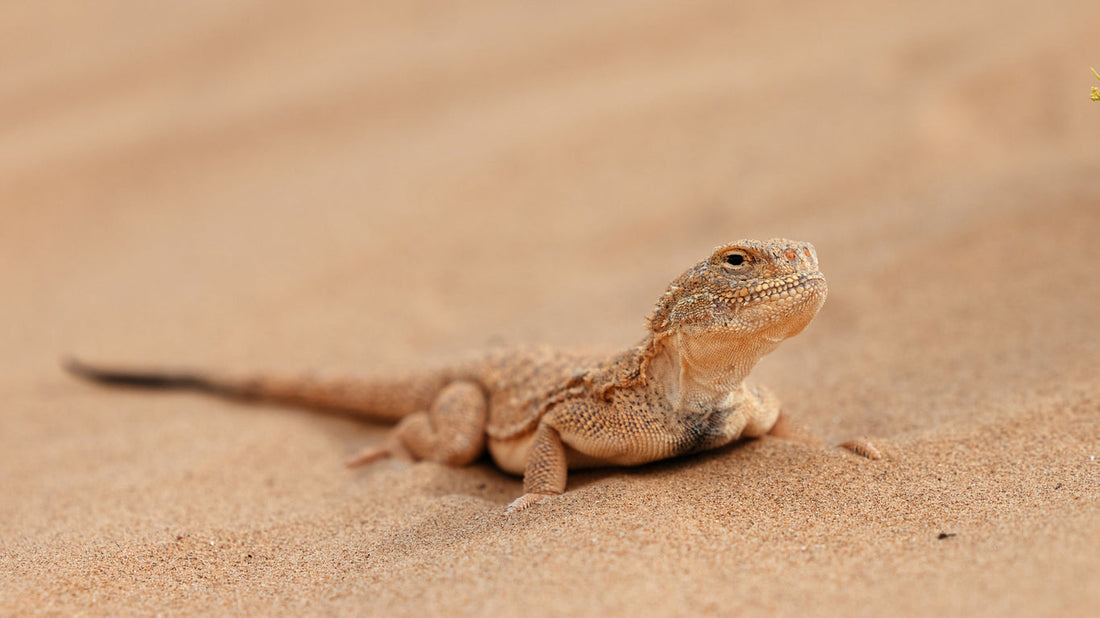Giant Toad-Headed Agama (Phrynocephalus spp.) Care Sheet
Quick Facts
Scientific Name: Phrynocephalus spp.
Common Names: Giant Toad-Headed Agama
Origin: Central Asia – deserts of Kazakhstan, Mongolia, and China
Adult Size: 25–35 cm (10–14 inches) total length
Lifespan: 8–12 years in captivity
Sex Differences: Males are typically larger and more brightly coloured with display markings; females are smaller and more muted in coloration
Beginner Suitability: Moderate – hardy species but requires precise temperature, lighting, and substrate
Enclosure
Size: Minimum 90 cm x 60 cm x 60 cm (3 ft x 2 ft x 2 ft) for a single adult. Larger enclosures are preferred to allow for activity and enrichment. Juveniles can be housed in smaller enclosures initially but must be upgraded as they grow.
Substrate: Use a mix of sand and soil (70% sand, 30% soil) to allow burrowing. Avoid substrates that can cause impaction. Include flat stones or rock slabs for basking.
Hides: Provide at least two hides—one on the hot side and one on the cool side. Include naturalistic hides such as cork bark, logs, or rock caves.
Heating: Maintain a hot spot of 35–38°C and a cool side of 24–27°C. Night temperatures can drop to 20–23°C. Use ceramic heat emitters or basking bulbs with a thermostat.
Lighting: UVB lighting is essential for health. Provide a 10–12% UVB bulb covering a significant portion of the enclosure. Maintain a 12-hour light / 12-hour dark cycle.
Humidity: Maintain 40–60% humidity. Mist lightly if necessary, but ensure good ventilation to prevent mould.
Diet
Primary Diet Type: Insectivore
Food Items: Feed gut-loaded insects such as crickets, locusts, mealworms, and roaches. Supplement occasionally with small amounts of plant matter if desired.
Feeding Frequency: Juveniles daily; adults every other day. Dust insects with calcium at every feeding and a multivitamin supplement once per week.
Feeding Troubleshooting: Ensure insects are appropriately sized (no larger than the width of the head). Vary diet items to encourage feeding.
Water
Provide a shallow water dish with fresh water at all times. Mist lightly once or twice a week for hydration, but avoid excess moisture.
Behavior And Handling
Giant Toad-Headed Agamas are semi-terrestrial and may be shy. Handle carefully and support the full body. They are solitary and should not be housed with others except during controlled breeding.
Enrichment
Provide branches, rocks, and hides for climbing and exploration. Include substrate suitable for digging and burrowing. Rearranging décor occasionally encourages natural behaviours.
Health
Signs of illness include lethargy, refusal to eat, abnormal stool, retained shed, or swelling. Maintain proper temperature, humidity, and diet. Consult a reptile-specialist veterinarian if issues persist.
Lifespan
Typically 8–12 years in captivity, with proper care and husbandry.
Legality In The UK
Giant Toad-Headed Agamas are legal to keep in the UK. No licence is required for private ownership. Owners must comply with Welfare of Animals regulations.
Difficulty Bars (Relative)
| Category | Level |
|---|---|
| Feeding | ███▁▁ Moderate (requires gut-loaded insects and occasional supplements) |
| Handling | ███▁▁ Moderate (shy, handle gently) |
| Humidity Needs | ███▁▁ Moderate (maintain 40–60%) |
| Enclosure Setup | ████▁ Moderate (temperature gradient and hides essential) |
| Beginner Suitability | ███▁▁ Moderate (best for attentive keepers) |

